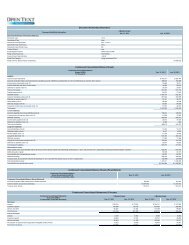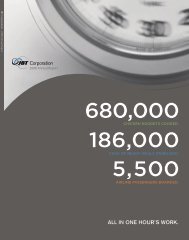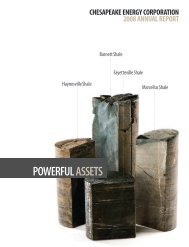FORM 10-K CONTANGO OIL & GAS COMPANY
FORM 10-K CONTANGO OIL & GAS COMPANY
FORM 10-K CONTANGO OIL & GAS COMPANY
Create successful ePaper yourself
Turn your PDF publications into a flip-book with our unique Google optimized e-Paper software.
<strong>CONTANGO</strong> <strong>OIL</strong> & <strong>GAS</strong> <strong>COMPANY</strong> AND SUBSIDIARIES<br />
NOTES TO CONSOLIDATED FINANCIAL STATEMENTS<br />
1. Organization and Business<br />
Contango Oil & Gas Company (collectively with its subsidiaries, “Contango” or the “Company”) is a<br />
Houston-based, independent natural gas and oil company. The Company’s business is to explore, develop, produce<br />
and acquire natural gas and oil properties primarily offshore in the Gulf of Mexico.<br />
2. Summary of Significant Accounting Policies<br />
Use of Estimates. The preparation of financial statements in conformity with accounting principles<br />
generally accepted in the United States requires management to make estimates and assumptions that affect the<br />
reported amounts of assets and liabilities and disclosure of contingent assets and liabilities at the date of the financial<br />
statements and the reported amounts of revenues and expenses during the reporting periods. Actual results could<br />
differ from those estimates.<br />
Revenue Recognition. Revenues from the sale of natural gas and oil produced are recognized upon the<br />
passage of title, net of royalties. Revenues from natural gas production are recorded using the sales method. When<br />
sales volumes exceed the Company’s entitled share, an overproduced imbalance occurs. To the extent the<br />
overproduced imbalance exceeds the Company’s share of the remaining estimated proved natural gas reserves for a<br />
given property, the Company records a liability. At June 30, 2009 and 2008, the Company had no material<br />
imbalances.<br />
Cash Equivalents. Cash equivalents are considered to be highly liquid investment grade debt investments<br />
having an original maturity of 90 days or less. As of June 30, 2009, the Company had $44.4 million in cash and<br />
cash equivalents. Of this amount, approximately $30.3 million was invested in U.S. Treasury money market funds<br />
and the remaining $14.1 million was invested in overnight U.S. Treasury funds.<br />
Accounts Receivable. The Company sells natural gas and crude oil to a limited number of customers. In<br />
addition, the Company participates with other parties in the operation of natural gas and crude oil wells.<br />
Substantially all of the Company’s accounts receivables are due from either purchasers of natural gas and crude oil<br />
or participants in natural gas and crude oil wells for which the Company serves as the operator. Generally, operators<br />
of natural gas and crude oil properties have the right to offset future revenues against unpaid charges related to<br />
operated wells.<br />
The allowance for doubtful accounts is an estimate of the losses in the Company’s accounts receivable. The<br />
Company periodically reviews the accounts receivable from customers for any collectability issues. An allowance<br />
for doubtful accounts is established based on reviews of individual customer accounts, recent loss experience,<br />
current economic conditions, and other pertinent factors. Accounts deemed uncollectible are charged to the<br />
allowance. Provisions for bad debts and recoveries on accounts previously charged-off are added to the allowance.<br />
Accounts receivable allowance for bad debt was $0 at June 30, 2009 and 2008. At June 30, 2009 and 2008,<br />
the carrying value of the Company’s accounts receivable approximates fair value.<br />
Net Income (Loss) per Common Share. Basic and diluted net income (loss) per common share has been<br />
computed in accordance with Statement of Financial Accounting Standard (“SFAS”) No. 128, “Earnings per Share”.<br />
Basic net income (loss) per common share is computed by dividing income (loss) attributable to common stock by<br />
the weighted average number of common shares outstanding for the period. Diluted net income per common share<br />
reflects the potential dilution that could occur if securities or other contracts to issue common stock were exercised<br />
or converted into common stock. See Note 7 – Net Income (Loss) Per Common Share for the calculations of basic<br />
and diluted net income (loss) per common share.<br />
DB2/2<strong>10</strong>43537.7 F-8










